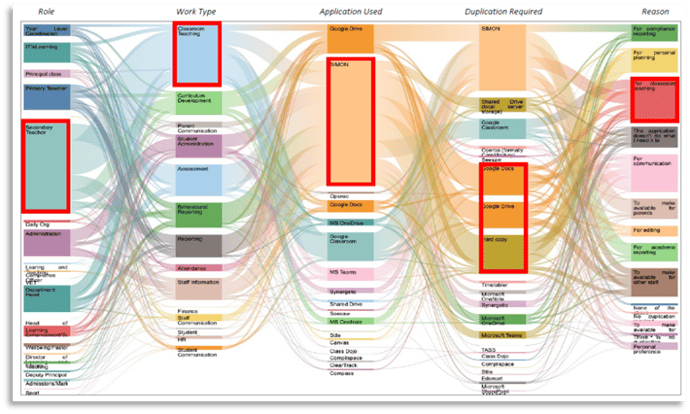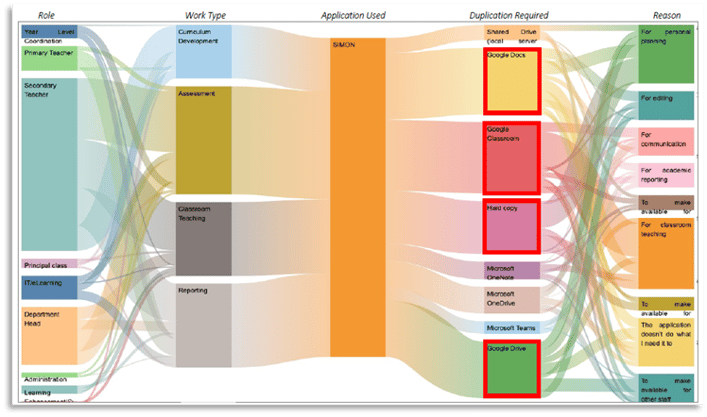A research study of 135 schools into their effectiveness of using learning and administration technologies.
The Secret
Every day at SIMON, our team works with the dedicated focus on delivering the best technology, service, and support for our schools in learning management and school administration. Sounds easy right? Well, let me fill you in on a little secret. It’s really, really hard.
Every school is unique. Every teacher is different. Every administrator has varied priorities and every parent wants everything delivered “immediately”. Oh, please bring back the days of when a technology fix usually involved “turning your computer off and then on”. Today, schools are more complex than any similar-sized organisation. Whilst many businesses may standardise on a handful of core applications, schools need to deliver an engaging learning experience aligned to the respective age group, subject, location, curriculum standard, individual skill set, level of collaboration, assessment type, individualised learning approach and all mandatory administration and reporting requirements – all this for just a teacher. Imagine extending this to the other common roles in a school such as a Principal, Department Head, Year Level Coordinator, IT Director, Finance, Enrolments and Wellbeing. I think you now see my point.
The Challenge
The SIMON learning management software solution is often the cornerstone of a school's system of applications, addressing many of the core business needs and activities, from parent communication, reporting and assessment to behavioural tracking.
It is also true that SIMON is but one of many applications in an interrelated system of applications which will have grown and evolved over time with changing needs and innovation. New applications are added, new ways of working emerge, and additional complexity is introduced into the system. This cycle manifests additional workflows, processes, costs and stress for teachers and administrators.
SIMON needed to examine the ways in which people conduct their work within and across applications, exposing the difference between design and reality. When done we examined the ways in which:
- SIMON interacts with other applications (or doesn't) at critical junctures in common workflows.
- Double-handling and highly manual, repetitive work
- Skills gaps and the impact on learning & teaching practice.
In total, 81 Secondary, 45 Primary, 2,471 users and 4,043 workflows were reviewed.
Discovering “Spaghetti Duplication”
The following chart visually represents the volume of workflows captured from schools which only use 32% of SIMON functionality supporting work types encompassing the major areas of:
- Classroom teaching
- Curriculum Development
- Parent and Student Communication
- Student Administration
- Assessment
- Behavioural Reporting
- Reporting
- Attendance
- Staff Information
- Finance
Each column represents an element of each workflow: role type, data type/activity, application being used to initiate the workflow, whether the data needed to be duplicated in another application and reason for duplication.

Chart 1: Duplication of workflows with schools using only 32% of SIMON features
Initial observation of the chart shows an incredibly high level of duplication of workflows against many different applications.
Upon further analysis of both survey data and qualitative interview data, it was wonderful to see that SIMON scored an average of 4.25 out of 5 against the features of:
- Assessment (rubrics, marking, feedback, assigning assessment tasks)
- Attendance (class rolls, arrivals/departures, absence notification
- Behavioural Management (students notes, permissions, pastoral incidents)
Now, you may be thinking SIMON is very self-indulgent to be bragging about the above data insight – well you are right. We are very proud of this, but as you will shortly read, SIMON has a bit of work to do in some other key areas.
Another key learning from this chart is that there is an invisible negative pattern bubbling beneath the surface influenced by this level of duplication – stress. We have observed that the higher the level of duplication, the higher the level of stress amongst teachers and staff.
From all workflow analyses, we identified that schools using only 32% of SIMON features experienced repeated workflows for 47% of related activity in other applications to get a desired outcome.
The schools that used 64% of SIMON features experience something far different.

Chart 2: Duplication of workflows with schools using 64% of SIMON features
The above chart highlights the workflow efficiencies when using a higher number of features within SIMON. We also recognised the decreased levels of frustration and stress.
The most common applications being used in schools are Google Classroom, MS Teams, Google Drive, MS OneDrive, Operoo, SeeSaw, Class Dojo, and the Student Management Systems. When we delve further into the “functions and purpose” of these applications, we start to gain a clearer picture where schools should focus their efforts in alleviating their duplication and stress pain.
Light at the End of the Tunnel
SIMON’s Systems Analysis has examined the ways in which schools conduct their work within and across applications, ascertaining workflows that bring efficacy in staff workloads, and those that decrease efficiency and impact on daily activity.
This analysis has confirmed assumptions on whether there is an ideal single “source of truth” application that will service all needs from a workflow activity perspective – this answer is no. However, what SIMON does provide is an application that, when utilisation is done right, offers a centralised learning management system that will create, curate and disseminate information alongside other systems to achieve and sustain operational efficiency.
The opportunities for schools to reduce workflow duplication and stress can be prioritised according to the following categories:
- Document Management
- Integrations: Google, Microsoft
- Parent Communications
- Push Notifications
- Mobile Applications
- NCCD and Behavioural Portals
- Training of Staff
- Learner Analytics and Insights being made available to students
Change Management
Educators and administrators have recently experienced significant pressures influenced by the pandemic and the resulting remote learning. Taking the initiative to reduce workflow duplication should be prioritised in a way which is aligned to your school’s culture, project experience and staff capacity.
We are certain that whilst SIMON is an excellent platform to engage your community, the fact is that a technology platform is only as good as your school’s ability to successfully engage with their users. Our recommendation is to take a moment’s pause to assess and discuss your current situation and discover not only what innovations exist in the education technology sector, but also internally reflect on your internal workflows and community wellbeing.
About the Author
Danny Gruber is the Business and Partner Manager at SIMON – a leading not-for-profit learning management and administration platform supporting over 250 schools across Australia. He has been working with schools for over 12 years and has conducted over 200 Strategic ICT Reviews of schools into how they plan, leverage, and use technology.
If you would like to learn more about SIMON or have a confidential discussion about your current school situation, please contact SIMON at: info@simonschools.net

.png)


